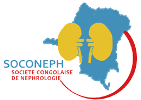Josée K. Tshituta1, François B. Lepira2*, François P. Kajingulu2, Jean Robert R. Makulo1, Ernest K. Sumaili2, Pierre Z. Akilimali3, Aliocha N. Nkodila4, Freddy M. Mbuyi1, Angèle I. Masewu1, Stéphane Mutombo1, Eric B. Amisi1, Jean Pierre M. Ilunga1, Wilfrid B. Mbombo1, Patrick M. Mukuna1, Adolphe M. Kilembe1
1Department of Anesthesiology and Reanimation, University of Kinshasa Hospital, Kinshasa, The Democratic Republic of the Congo
2Division of Nephrology, Department of Internal Medicine, University of Kinshasa Hospital, Kinshasa, The Democratic Republic
of the Congo
3Department of Epidemiology & Biostatistics, Kinshasa School of Public Health, University of Kinshasa School of Medicine,
Kinshasa, The Democratic Republic of the Congo
4Centre medical cite des Aveugles, Kinshasa, The Democratic Republic of the Congo
Email: *lepslepira@yahoo.fr, *fr.lepira@gmail.com
Abstract
BACKGROUND AND AIM: Although admission hyperglycemia has been reported to be associated with unfavorable outcomes in acute stroke, little is known about this association in sub-Saharan Africa. Therefore, the aim of the present study was to assess the prognostic significance of admission hyperglycemia in the acute phase of stroke in Congolese patients. METHODS: In a multicenter prospective cohort study, consecutive patients with acute stroke were examined in 5 Emergency Rooms or Intensive Care Units of Kinshasa between July 15th, 2017 and March 15th, 2018. The severity of stroke was assessed at admission using the Glasgow Coma Scale. Stress hyperglycemia was
defined as random blood glucose levels at admission > 140 mg/dL in patients without known type 2 diabetes mellitus (T2DM). The endpoint was 10-day all-cause in-hospital mortality. Survival (time-to-death) curves were built using the Kaplan Meier methods. Cox proportional analysis was used to identify predictors of 10-day all-cause in-hospital mortality. The predictive performance of blood glucose level to predict 10-day all-cause in-hospital mortality was assessed using ROC curve analysis. RESULTS: Out of 194 patients (mean age 58.7 ± 13.1 years; 64% males, 74.7% light to moderate stroke severity; 63.4% ischemic stroke) enrolled, 106 (54.6%) had admission hyperglycemia with 77 (72.6%) having stress hyperglycemia. Ninety four deaths (48.5%); mortality rate of 6 deaths per 100 person-days (95%CI 2.7 – 9.3) occurred
during a median follow up time 6 (5 – 7) days equivalent to 1542 person-days.
Independent predictors of 10-day all-cause in-hospital mortality were admission hyperglycemia regardless of diabetes status (aHR 3.77; 95%CI 1.92 – 7.42; p < 0.001), GCS < 8 (aHR 2.87; 95%CI 1.57 – 5.23; p = 0.001) and non-use of mechanical ventilation (aHR 1.97; 95%CI 1.05 – 3.70; p = 0.034). Blood glucose concentrations (AUC 0.743; 95%CI 0.672 – 0.814) had a better predictive performance for 10-day all-cause in-hospital mortality with an optimal value of 154 mg/dL (sensitivity 76.6% and specificity 70%). CONCLUSION: More than half of critically ill stroke patients exhibit admission hyperglycemia that impacts negatively on their survival in the acute phase highlighting thus the
need for a better blood glucose control to improve outcomes.
